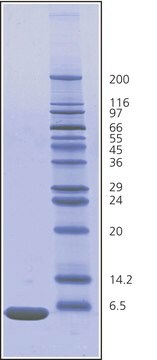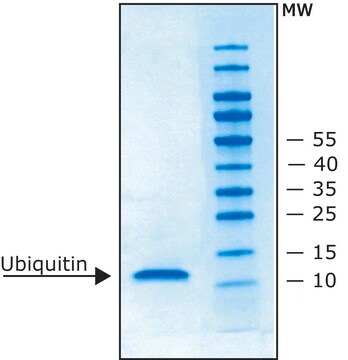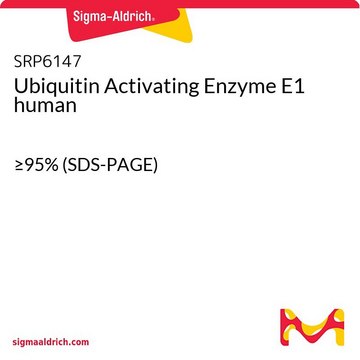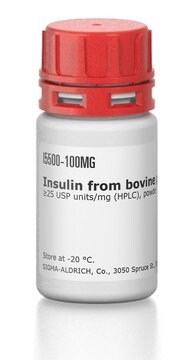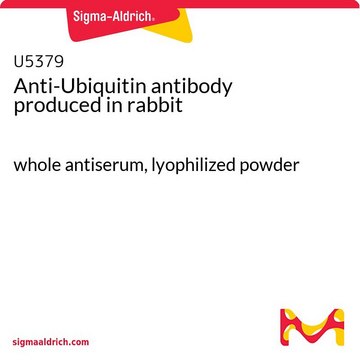U5382
Ubiquitin human
≥95% (SDS-PAGE), recombinant, expressed in E. coli (N-terminal FLAG® tagged), lyophilized powder
Sign Into View Organizational & Contract Pricing
All Photos(1)
About This Item
Recommended Products
biological source
human
Quality Level
recombinant
expressed in E. coli (N-terminal FLAG® tagged)
Assay
≥95% (SDS-PAGE)
form
lyophilized powder
mol wt
10 kDa
technique(s)
mass spectrometry (MS): suitable
solubility
0.05 M Tris pH 7.5: ≥10 mg/mL, clear to slightly hazy, colorless
0.05 M Tris pH 7.5: ≥10 mg/mL
storage temp.
−20°C
Looking for similar products? Visit Product Comparison Guide
General description
Research Area: CANCER
Ubiquitin is a highly conserved protein composed of 76 amino acids, and it is expressed universally in all eukaryotes, ranging from yeast to humans.
Ubiquitin is a highly conserved protein composed of 76 amino acids, and it is expressed universally in all eukaryotes, ranging from yeast to humans.
Ubiquitin is a highly conserved globular protein and has lysine in the surface. The C-terminal end comprises the Leu-Arg-Gly-Gly structural motif.
Application
Ubiquitin human can be used as a standard for mass spectrometry.
Ubiquitin human has been used in mono-ubiquitination of yeast proliferating cell nuclear antigen (PCNA) and in in vitro ubiquitination assay of defective in mitotic arrest 1 (Dma1)
Ubiquitin, N-terminal FLAG-tagged can replace the ubiquitin in formation of poly-ubiquitin—protein conjugates. The FLAG tag enables separation and enrichment of the protein conjugates on anti-FLAG affinity columns and detection of conjugates in western blot by anti-FLAG antibodies.
Biochem/physiol Actions
Ubiquitin interacts with the lysine residue of proteins through its ε-amino group of the C-terminal glycine residue. Proteins interacting with ubiquitin either undergo mono-ubiquitination or multi-mono-ubiquitination via a three-step process. Ubiquitination regulates intracellular trafficking and protein degradation and an imbalance in the pathway is implicated in disorders.
Ubiquitin is a small regulatory protein present in eukaryote tissues. Exogenous ubiquitin can stimulate apoptosis in numerous cell lines. E7 protein of human papilloma virus-16 stimulates Retinoblastoma Protein degradation via Ubiquitin-Proteasome Pathway.
Ubiquitin-mediated proteolysis plays an important role in several basic cellular processes including regulation of cell cycle and division, differentiation and development, modulation of cell-surface receptors, the secretory pathway (protein transport), morphogenesis of neuronal networks, transcriptional regulation and signal transduction, transcriptional silencing, DNA repair, long-term memory, and circadian rhythms.
Packaging
Package size based on protein content
Preparation Note
Ubiquitin human can be dissolved in 0.05 M Tris-HCl at a concentration of 10.00 - 11.00 mg/ml to yield a clear to slightly hazy, colorless solution.
Legal Information
FLAG is a registered trademark of Merck KGaA, Darmstadt, Germany
Storage Class Code
11 - Combustible Solids
WGK
WGK 3
Flash Point(F)
Not applicable
Flash Point(C)
Not applicable
Personal Protective Equipment
dust mask type N95 (US), Eyeshields, Gloves
Choose from one of the most recent versions:
Already Own This Product?
Find documentation for the products that you have recently purchased in the Document Library.
Customers Also Viewed
David Komander
Biochemical Society transactions, 37(Pt 5), 937-953 (2009-09-17)
Protein ubiquitination and protein phosphorylation are two fundamental regulatory post-translational modifications controlling intracellular signalling events. However, the ubiquitin system is vastly more complex compared with phosphorylation. This is due to the ability of ubiquitin to form polymers, i.e. ubiquitin chains
Ana Camara-Artigas et al.
Acta crystallographica. Section F, Structural biology communications, 72(Pt 1), 29-35 (2016-01-12)
Ubiquitin is a small globular protein that has a considerable number of lysine residues on its surface. This results in a high surface entropy that precludes the formation of crystal-packing interactions. To date, only a few structures of the native
Boris Macek et al.
Molecular & cellular proteomics : MCP, 5(5), 949-958 (2006-02-16)
Top-down proteomics, the analysis of intact proteins (instead of first digesting them to peptides), has the potential to become a powerful tool for mass spectrometric protein characterization. Requirements for extremely high mass resolution, accuracy, and ability to efficiently fragment large
Anthony O Gramolini et al.
Molecular & cellular proteomics : MCP, 7(3), 519-533 (2007-12-07)
Defective mobilization of Ca2+ by cardiomyocytes can lead to cardiac insufficiency, but the causative mechanisms leading to congestive heart failure (HF) remain unclear. In the present study we performed exhaustive global proteomics surveys of cardiac ventricle isolated from a mouse
B L Brizzard et al.
BioTechniques, 16(4), 730-735 (1994-04-01)
The FLAG epitope is an eight amino acid peptide (AspTyrLysAspAspAspAspLys) that is useful for immunoaffinity purification of fusion proteins. A monoclonal antibody (anti-FLAG M1) that binds the FLAG epitope in a calcium-dependent manner and requires an N-terminal FLAG sequence has
Our team of scientists has experience in all areas of research including Life Science, Material Science, Chemical Synthesis, Chromatography, Analytical and many others.
Contact Technical Service